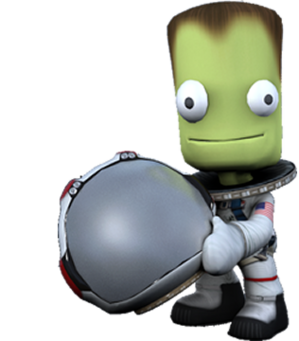Kerbal: Difference between revisions
mNo edit summary |
mNo edit summary |
||
| Line 1: | Line 1: | ||
[[File:Kerbal helmet off (1).png|thumb|341x341px|An adult Kerbal male wearing a space suit]] |
[[File:Kerbal helmet off (1).png|thumb|341x341px|An adult Kerbal male wearing a space suit]] |
||
| − | '''Kerbals''', ('''''Kerbos Kermulon''''') are the most common and widespread species of animal on [[Kerbin]]. Characterized by their bipedalism and intelligent, albeit clumsy nature, kerbals have a highly developed cognitive array that has enabled them to thrive in many environments across the planet, and develop complex societies and civilizations. |
+ | '''Kerbals''', ('''''Kerbos Kermulon''''') are the most common and widespread species of animal on [[Kerbin]]. Characterized by their bipedalism and intelligent, albeit clumsy nature, kerbals have a highly developed cognitive array that has enabled them to thrive in many environments across the planet and beyond, and develop complex societies and civilizations. |
== Biology == |
== Biology == |
||
Revision as of 18:39, 22 June 2023
Kerbals, (Kerbos Kermulon) are the most common and widespread species of animal on Kerbin. Characterized by their bipedalism and intelligent, albeit clumsy nature, kerbals have a highly developed cognitive array that has enabled them to thrive in many environments across the planet and beyond, and develop complex societies and civilizations.
Biology
Anatomy and Physiology
Kerbals are invertebrate mammalian bipeds with five major bodily protrusions; two legs, two arms and a head on top of their torso. Kerbals stand roughly 0.75 meters tall (2'5½") on average and weigh between 40kg (88.2lb) to 70kg (154.3lb). They have four digits on both their hands and feet. Kerbal skin is green, with variations in hue being a product of genetics, climate and age.
There is a great deal of biological variation in kerbals – with traits such as blood type, genetic diseases, cranial features, facial features, organ systems, eye color, hair color and texture, height and build, and skin color varying across the globe.
Life Cycle
A kerbal can live for up to 120 years, though an average lifespan may be around 100. This value has fluctuated in modern times, primarily dropping during the Great Decline. Disease, trauma resulting from accidents, and old age are the most common causes of death.
Culture
Society
Kerbals are highly social, and tend to form large and complex societal systems and groups.
Government and Politics
Trade and Economics
Conflict
god there's so much of it
